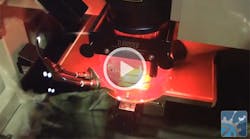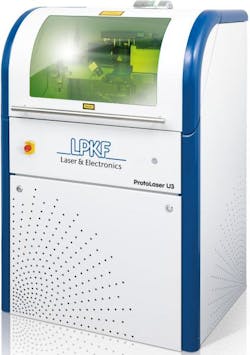UV Laser Delamination Raises the Rapid-Prototyping Bar
Watch the Engineering TV video above to see the ProtoLaser U3 in action.
To accelerate 2D-surface prototyping, LPKF equipped its ProtoLaser U3 with an ultraviolet (UV) laser to selectively delaminate and cut substrates. The system, which requires only an electrical connection, dust extraction, and compressed air, can be used on a variety of materials, including ceramic, LTCC (green tape), FR4, Rogers, protective sheets, and metal foils or flexible and flex-rigid materials.
The high pulse energy of the system’s UV laser eliminates residue from the ablation process, resulting in more geometrically exact contours. It also allows for the processing of unusual materials and complex substrate structures, as well as multi-layer productions. The laser uses no environmentally hazardous chemicals and is contact-free, suiting it for sensitive materials. Automatic setting of the laser’s optimal focal position enables more accurate repetition. The material struck by the laser vaporizes in a fraction of a second, leaving virtually no residue.
Capable of structuring laminated substrates, the system produces ultra-fine conductors with a 70-μm line width and 30-μm distance, while simultaneously gently removing large metal surfaces. As a result, it will find homes in high-precision geometry, high-repeat accuracy, and layout data-protection applications. According to LPKF,
First, it produces the contours of the conductor path structure; then it removes the remaining copper surfaces using reduced power. For this process, a specialized hood is required which, along with the dust extraction, also has a compressed air feature. Both hoods and the LPKF CAM software are included in delivery.
Touted as the first hybrid milling/laser system, its speed—capable of completing a prototype in three minutes—will fit well in R&D as well as small-scale production. The ProtoLaser U3 was unveiled for the first time at this year’s International Microwave Symposium (IMS). Watch the video above for a look at the system, courtesy of Technical Editor, Jean-Jacques DeLisle. Also be sure to check out other videos from IMS 2014 over at Engineering TV.

